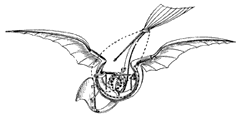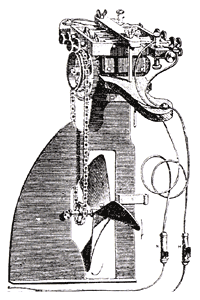 In the 1950s, planes crashed with alarming frequency into city neighborhoods near the Minneapolis-St. Paul airport. At least one devoured a house nearl where I now live, in Southwest Minneapolis. I heard from older neighbors about the time an airplane crashed in my neighborhood. It set me to thinking. Here's my story on it:
In the 1950s, planes crashed with alarming frequency into city neighborhoods near the Minneapolis-St. Paul airport. At least one devoured a house nearl where I now live, in Southwest Minneapolis. I heard from older neighbors about the time an airplane crashed in my neighborhood. It set me to thinking. Here's my story on it:In 1984, I took a job with Northwestern Bell Telephone Company as an engineer in their plant operations department. Part of my responsibilities required me to visit the phone company buildings in locations throughout the western part of Minnesota. The duty route included places like Pipestone, Willmar, Marshall, Detroit Lakes and Granite Falls. An older engineer accompanied me, and he and I would spend the long time in the car driving between towns talking about one thing or another.
The engineer, Vince, was a technician and teacher, and extremely well versed in the operation and theory of most things mechanical. We spent long hours talking about mechanical things -- cars, air conditioners, locomotives, power plants, that kind of stuff.
He would also talk about his family. He had two children, and given his age, his kids were surprisingly young. "They're my second family," he said.
I figured he meant that he had remarried and had more children with his second wife. "No, I've been married to the same woman all my life," he said. "I lost my first children in an accident when they were very young."
The engineer then told me he lost his "first" family when an airplane crashed into his Minneapolis home. This troubled me greatly. I really liked the old engineer and while I didn't want to press him for details, I did want to know more.
While his story seems like one of incredible bad luck and improbability, it really isn't so. In fact, my research shows that in the years 1950 through 1956, planes fell from the sky on south Minneapolis with astounding frequency -- dramatic enough to make news, but not so unusual to be considered really exotic. Almost every year, some poor homeowner, golfer or motorist would be quietly reading at home, golfing or simply driving down the road, minding their own business, when an airplane would suddenly and unexpectedly fall in front of them killing pilots, passengers and sometimes, neighborhood residents as well.
On March 7, 1950, a Northwest Orient Airlines airplane flying in from Madison, Wisconsin, with 13 people aboard was on its final landing approach into what is now runway 12-R at the airport. The landing was ill-advised. A powerful March snowstorm was underway, with high winds, and near-whiteout conditions.
The pilot elected to land and, in doing so, clipped a flagpole at Fort Snelling with his left wing. Now committed to getting his damaged airplane on the ground, the pilot pulled back on the throttle to gain altitude and made a big swing around South Minneapolis to take another try at 12-R.
The plane was too damaged to make it. Its mangled wing fell off and hit the Washburn water tower, with the wingtip landing on the tower's south lawn. The fuselage then plunged onto Minnehaha Parkway between Emerson and Dupont avenues, smashing into three houses before coming to rest on the banks of the creek.
Residents heard the airplane's engines groan and labor even over the roar of the storm before impact. "I heard that plane come in very, very low," said one resident. "You could tell something was wrong."
On Minnehaha Parkway, smoke and fire were everywhere. Firefighters rushed to the scene, but there was little to do except smother flames and extract the dead. Thirteen passengers and crew were gone, plus two children on the ground, crushed to death in their sleep by a falling airplane.
Vince's tale was equally horrific. On a hot and sunny Saturday in June 1956, he was out watering his South Minneapolis lawn while the neighborhood children were happily splashing around in a small plastic swimming pool in the adjacent neighbor's yard.
Suddenly and with almost no warning, a fighter plane -- a Navy F9F "Panther" Jet -- fell from the sky with a terrible commotion. The jet, loaded with fuel, hit the ground nose-first in the middle of 44th Avenue between 59th and 60th streets. This particular type of jet carried 500 gallons of aviation-grade gasoline in each of its wingtip fuel tanks. A fireball roared upwards, and as it did, the remains of the aircraft rolled, bounced and splattered into several houses, coming to a burning halt in the very spot where the neighborhood children had been playing moments before.
Immediately, the flight crew and four people on the ground were killed. Some kids were able to run from the wreckage, clothes and body covered with burning gasoline. The adults in the neighborhood rushed to grab them and extinguish the fire.
Firefighters arrived quickly, but great damage to the neighborhood and the families living in the quiet South Minneapolis neighborhood had been done.
Over the next several weeks, several more children succumbed to their burns. When it was over, at least nine people -- including seven children on the ground -- were dead, victims of an unpredictable intrusion from above.
There were other a number of other crashes near Minneapolis. In 1948, an army airplane crashed on a spot where the Mall of America now sits. At the time, that area was a swamp, so no one on the ground were hurt, but the people on the airplane were killed. In 1951, three Navy fliers died when their twin-engine Beech crashed while landing on a southeast airport approach. Their plane just missed Fort Snelling's living quarters, striking a tree and bursting into flames on a golf course -- shocking, but not killing, golfers in the clubhouse.
In 1956, another military plane -- an Air Force F89 Scorpion jet fighter carrying 104 live air-to-ground rockets -- had catastrophic engine failure at takeoff. It crashed into a sedan carrying a family on the airport frontage road, where Highways 5 and 494 are today. Two of the car's four occupants - a five-year-old girl and her mother -- were killed. The pilots were able to eject safely.
I visited the Minnehaha Parkway crash site recently. As one would expect after so much time, no evidence remains of the crash. However, one home is clearly of 1950s vintage, its low roof and windowed-side porch of an obviously different architectural style from its 1920s neighbors. It's differentness is a reminder of what happened on that spot 50 years ago.














